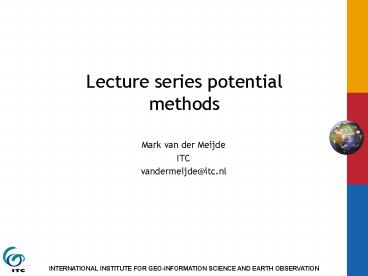Lecture series potential methods - PowerPoint PPT Presentation
1 / 28
Title:
Lecture series potential methods
Description:
INTERNATIONAL INSTITUTE FOR GEO-INFORMATION SCIENCE AND EARTH OBSERVATION ... A large direct current is passed through a large ungrounded loop transmitter. ... – PowerPoint PPT presentation
Number of Views:28
Avg rating:3.0/5.0
Title: Lecture series potential methods
1
Lecture series potential methods
- Mark van der Meijde
- ITC
- vandermeijde_at_itc.nl
2
Time-Domain EM
3
TDEM
- The continuous wave field (FDEM) methods
discussed previously essentially involve
measurement of a small secondary field in the
presence of a much larger primary field which
results in a decrease of accuracy. - This problem is overcome in time-domain
electromagnetic systems (TDEM) by use of
transient pulses instead of continuous waves.
4
TDEM
- A large direct current is passed through a large
ungrounded loop transmitter. - After a discrete period of time the current is
turned off and the measurements begin. - Opposite to Freq EM
- Direct current instead of alternating
- Measurement during time off
5
- Because transmitting current is off during
measurements the secondary current which is
generated can be measured relatively easy.
6
TDEM
- Question
- How can we apply Faraday and Amperes law in the
case of TDEM???? - What is causing electromagnetic field in this
case?
7
TDEM
- After a discrete time (tens of milliseconds),
during which transient signals due to turning
current on dissipated, the applied current is
interrupted abruptly. - If a conductor is present in the vicinity, the
sharp change in the primary field will induce
secondary currents within the conductor,
initially at the surface only
8
TDEM
- This is known as early-time stage of the
transient process. These surface currents start
dissipating through Ohmic losses. - The zone immediately within the conductor then
experiences a decreasing magnetic field with a
consequential flow of secondary currents through
it (Eddy currents). - This is the start of inward diffusion of the
current pattern, of the secondary field, towards
the interior of the conductor - ? Intermediate-time transient process
9
TDEM
- The final or late-time stage of this process is
reached when the induced current distribution is
invariant with time - The only change observed is a decrease in the
overall amplitude with time - ? No variation, no contribution from secondary
field due to conductor anymore!!
10
TDEM
- The initial distribution of surface current is
dependent only on the size and shape of the
conductor (as geometrical factor) and NOT due to
the conductivity of the body!!! - If the conductor is very large compared to the
used dipole source the secondary field might not
only diffuse inside the body but also spread
outward. This is dependent on the size, shape AND
conductivity of the body.
11
TDEM
- The whole process of the step-wise excitation of
the current loop is repeated many times and are
stacked for each location - Within highly conductive bodies the decay of the
eddy (secondary) currents and therefore the
secondary magnetic field is significantly slower
than that in poor conductors. - Measurement of the rate of decay of the secondary
field thus provides a means of detecting
conductive bodies and estimating their
conductivity.
12
TDEM configurations
- Two possible TDEM configurations
- Loop-loop slingram
- Central loop sounding mode
13
Principle of TDEM signal transmission
Loopsize 25x25 to 500x500 m
14
Principle of TDEM receiver
Receiver output wave form
Transient current flow into the ground
15
Receiver signal
Receiver signal is measured in time-slices
Logplot of receiver output voltage vs time
16
Apparent resistivity vs time
Apparent resistivity for a homogeneous halfspace
Apparent resistivity for a two-layered earth
17
Receiver output two layered earth
18
Two-layered earth models
Forward calculated curves for 2-layered earth
models
19
Inversion example
20
Inversion example
blocking Layer
21
- Estimating amount of layers visually (like in
resistivity) is not straightforward in TDEM - Inversion is needed for interpretation, almost
never done manually, always with computer - No standard interpretation curves available
- Conductive layers limit depth resolution and can
function as barrier for deeper investigations - Depth of penetration is strongly depending on
this factor! Any reason for less depth
penetration can most often be explained by high
conductivity bodies/layers
22
Case study groundwater
HoekstraBlohm, 1990
23
Case study groundwater
HoekstraBlohm, 1990
24
Case study groundwater
HoekstraBlohm, 1990
25
Case study contamination
Hoekstra et al, 1992
26
Case study contamination
Model ?
Hoekstra et al, 1992
27
Case study contamination
Hoekstra et al, 1992
28
Different TDEM
- Last note on different TDEM equipments. Some
measure in microseconds others in nanoseconds. - The latter are called nanotem and have far more
accuracy and get more and more popular. - First one was called (surprise) NanoTem, nowadays
also FastTem














![Lecture note : Gas chromatography [2] ????????? ??? PowerPoint PPT Presentation](https://s3.amazonaws.com/images.powershow.com/6741367.th0.jpg?_=20150612015)
















![Artificial Intelligence Lecture 8: [Part I]: Selected Topics on Knowledge Representation PowerPoint PPT Presentation](https://s3.amazonaws.com/images.powershow.com/7421234.th0.jpg?_=20151128083)